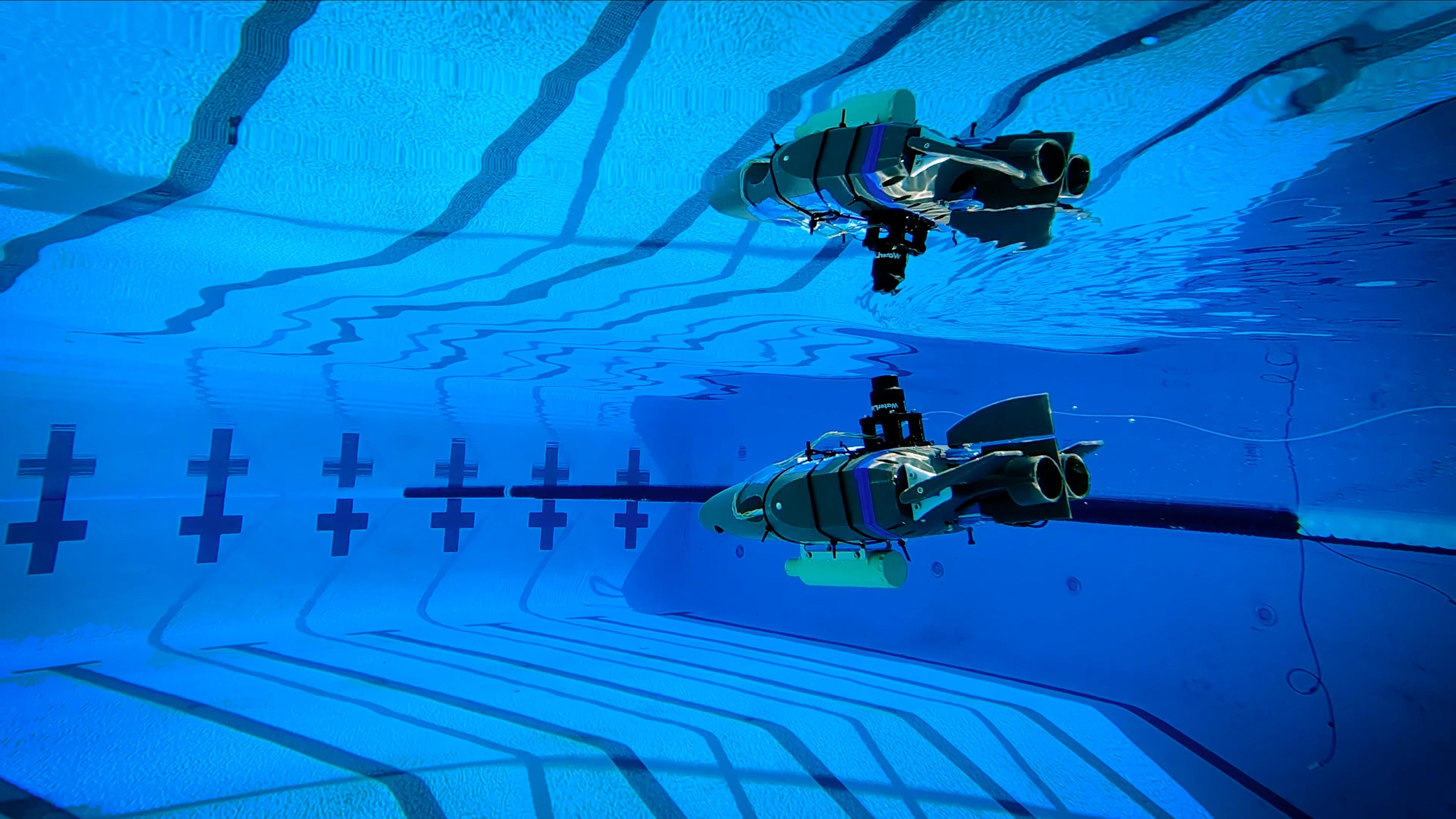55 Years Ago: Seven Months Before the Moon Landing
December 1968 ended a year more turbulent than most. For the American space program, however, it brought the Moon landing one giant step closer. The successful first lunar orbital flight by Apollo 8 astronauts Frank Borman, James A. Lovell, and William A. Anders proved the space worthiness of the Apollo Command and Service Modules (CSM) […]

December 1968 ended a year more turbulent than most. For the American space program, however, it brought the Moon landing one giant step closer. The successful first lunar orbital flight by Apollo 8 astronauts Frank Borman, James A. Lovell, and William A. Anders proved the space worthiness of the Apollo Command and Service Modules (CSM) at lunar distances and demonstrated navigation beyond low Earth orbit. Preparations continued for the next two missions – Apollo 9 to test the Lunar Module (LM) in Earth orbit in February or March 1969, and Apollo 10 to repeat the test in lunar orbit in May. If those missions proved successful, NASA hoped to achieve the first Moon landing by the summer of 1969.



Left: Apollo 8 astronauts James A. Lovell, left, Frank Borman, and William A. Anders during the preflight crew press conference. Middle: At the White House, Apollo 7 astronauts R. Walter Cunningham, left, Donn F. Eisele, and Walter M. Schirra, Apollo 8 astronauts Anders, Lovell, and Borman, standing at right, watch aviation pioneer Charles A. Lindberg sign a commemorative document, as First Lady “Lady Bird” Johnson, President Lyndon B. Johnson, former NASA Administrator James E. Webb, and Vice President Hubert H. Humphrey look on. Right: During the countdown demonstration test, Borman, standing left, Lovell, and Anders pose with their backups Neil A. Armstrong, kneeling left, Edwin E. “Buzz” Aldrin, and Fred W. Haise.
On Dec. 2, Borman, Lovell, and Anders held their preflight press conference at the Manned Spacecraft Center (MSC), now NASA’s Johnson Space Center in Houston. Borman summed up the crew’s readiness, “I think we can say we’re ready two weeks before” the flight. President Lyndon B. Johnson invited Apollo 7 astronauts Walter M. Schirra, Donn F. Eisele, and R. Walter Cunningham to a state dinner at the White House on Dec. 9, 1968. He also invited Apollo 8 astronauts Borman, Lovell, and Anders, just 12 days from their historic launch to the Moon, as well as aviation pioneer Charles A. Lindberg to sign a commemorative document to hang in the White House Treaty Room. Two days later, Borman, Lovell, and Anders and their backups Neil A. Armstrong, Edwin E. “Buzz” Aldrin, and Fred W. Haise participated in the countdown demonstration test at NASA’s Kennedy Space Center (KSC) in Florida.



Left: The Apollo 8 launch vehicle at Launch Pad 39A during the countdown demonstration test. Middle: Apollo 8 crew of William A. Anders, left, Frank Borman, and James A. Lovell at the Command Module simulator at NASA’s Kennedy Space Center in Florida. Right: Lovell, left, Borman, and Anders enjoy some pre-holiday cheer on the eve of their launch to the Moon.
Engineers at KSC’s Launch Complex 39 completed the Apollo 8 Countdown Demonstration Test (CDDT) between Dec. 5 and 11, consisting of “wet” and “dry” phases. In the first wet phase, they simulated the entire countdown including the loading of propellant in the rocket’s three stages, down to T minus 8.9 seconds, the time when the first stage’s five F-1 engines ignite. For safety reasons, the crew did not participate in the wet countdown. At the end of the wet phase on Dec. 10, workers drained the fuel from the rocket and recycled the countdown. The next day, the countdown again proceeded to the point of first stage ignition, but for this dry phase the astronauts suited up and strapped into the capsule as they would on launch day. The CDDT also tied in the Mission Control Center (MCC) at MSC, and the Manned Space Flight Network, a series of tracking stations around the world used to monitor the mission. With the CDDT completed, the countdown for Apollo 8 began on Dec. 15.



Left: Liftoff of Apollo 8. Middle: A rapidly receding Earth shortly after Trans-Lunar Injection. Right: The spent S-IVB third stage with the Lunar Module (LM) Test Article-B (LTA-B) visible where a LM would normally reside.
On Dec. 21, 1968, at precisely 7:51 a.m. EST, at Launch Pad 39A the five engines of the Saturn V’s first stage came to life, powering up to their full 7.5 million pounds of thrust. The brilliance of the flame rivaled the sunrise. At the top of the rocket, strapped inside their Command Module (CM), Borman, Lovell, and Anders experienced firsthand the power of a Saturn V launch. As soon as the rocket cleared the launch tower, control of the mission transferred from the Launch Control Center at Launch Complex 39 to MCC at MSC. From there, three teams of controllers, led by Lead Flight Director Clifford E. Charlesworth and Flight Directors Glynn S. Lunney and Milton L. Windler, working in eight-hour shifts, monitored the mission until splashdown. During the launch and early phases of the flight, Michael Collins served as the capsule communicator, or capcom, the astronaut in MCC who spoke directly with the crew. Within 11 and a half minutes, the three stages of the Saturn V placed Apollo 8 into Earth orbit. For the next 90 minutes, MCC and the astronauts thoroughly checked out the spacecraft’s systems, and capcom Collins informed the crew, “You are go for TLI,” or Trans-Lunar Injection, a less than dramatic way of saying “You’re off to the Moon!” Those words committed the mission to break the bonds of Earth’s gravity and set a course for the Moon. Near the end of the second revolution around the Earth, the rocket’s third stage engine fired for a second time, for more than five minutes, increasing Apollo 8’s speed from 17,400 miles per hour to 24,226 miles per hour, enough to overcome Earth’s gravity and send it on a Moonward trajectory. Soon after the burn ended, the astronauts separated their spacecraft from the spent stage and began their three-day cruise to the Moon.
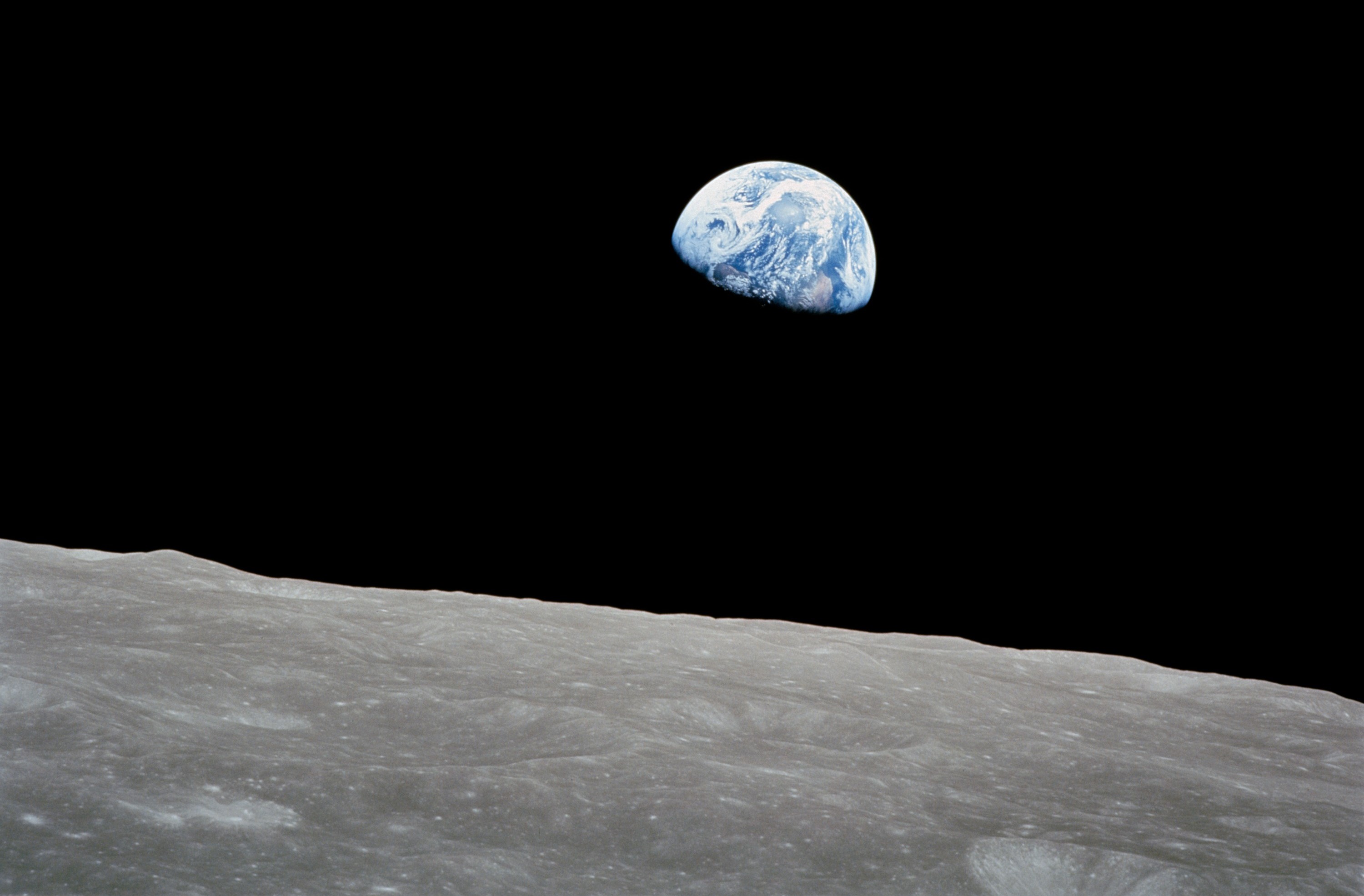
The famous Earthrise photograph from Apollo 8.
During the journey, Borman, Lovell, and Anders passed through the Earth’s Van Allen radiation belts and crossed into the Moon’s gravitational sphere of influence. About 69 hours after launch, Apollo 8 passed the leading edge of the Moon and disappeared behind it, all communications with Earth cut off. While behind the Moon, the astronauts performed the Lunar Orbit Insertion maneuver, but for a few anxious minutes, only they knew that their spacecraft’s engine had performed as expected. As they emerged on the Moon’s other side precisely at the predicted time, MCC confirmed that Apollo 8 had achieved lunar orbit. The astronauts began to describe the Moon as no other humans had seen it before.



Left: The Tsiolkovski Crater on the Moon’s farside, seen directly by human eyes for the first time during Apollo 8. Middle: Apollo 8 shortly after splashdown, with the astronauts in the life raft awaiting pick up by the recovery helicopter. Right: Apollo 8 astronauts arrive on the prime recovery ship U.S.S. Yorktown.
For the next 20 hours, they orbited the Moon 10 times. On their ninth revolution, knowing that Christmas Eve had turned to Christmas Day, Borman, Lovell, and Anders read from The Bible’s Book of Genesis and wished everyone on “the good Earth” a Merry Christmas. On their final revolution, they disappeared behind the Moon one last time and fired their spacecraft’s engine to propel them out of lunar orbit to head back toward Earth. Once they reestablished contact at the predicted time, Lovell proclaimed, “Please be informed there is a Santa Claus,” his way of saying that the engine burned as expected. The astronauts spent the next three days coasting back toward Earth, ending their historic six-day mission with a predawn splashdown in the Pacific Ocean. Teams from the prime recovery ship U.S.S. Yorktown (CV-10) recovered them from the water and brought them aboard the carrier.


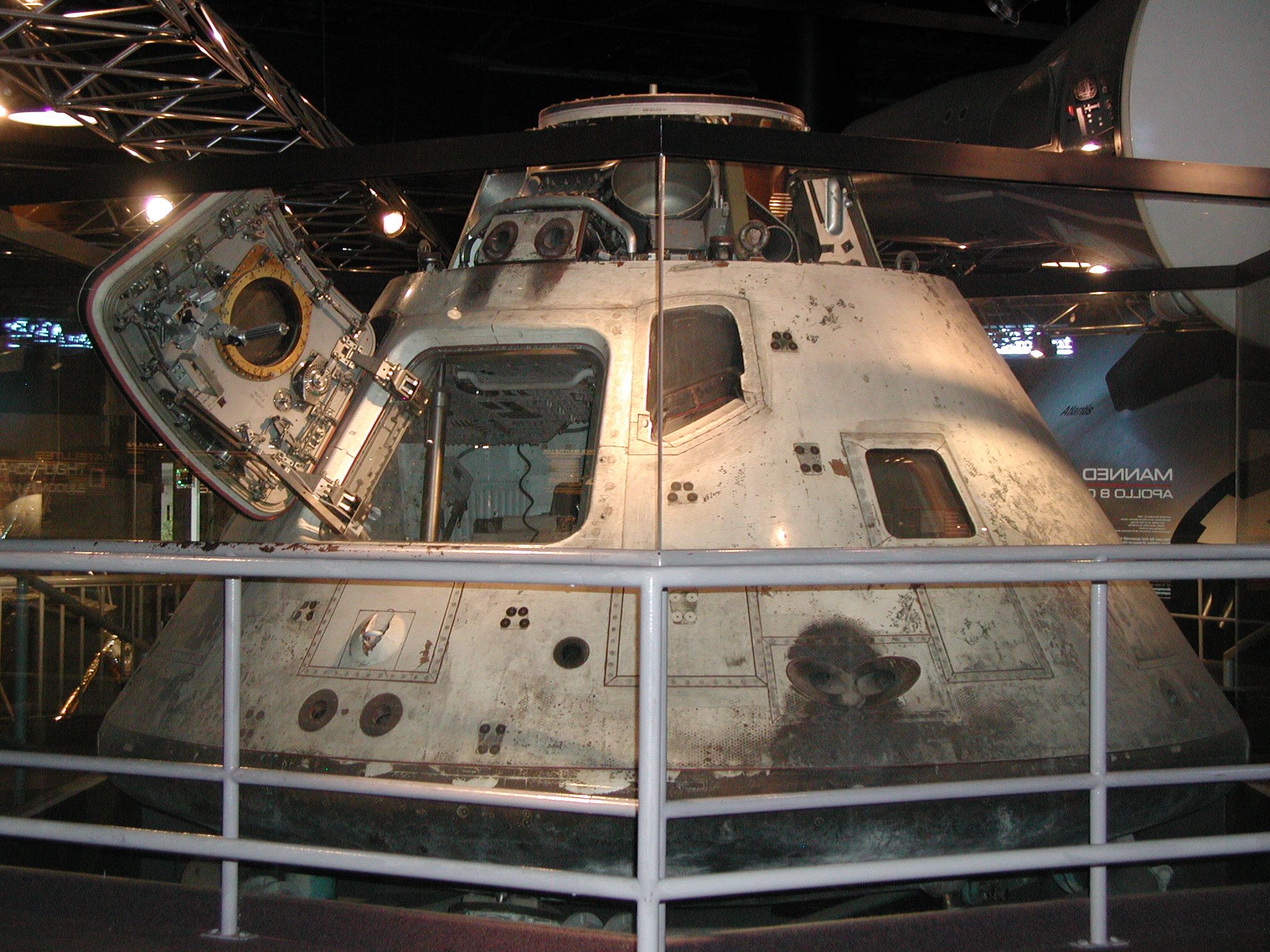
Left: Apollo 8 astronauts (wearing leis) William A. Anders, left, James A. Lovell, and Frank Borman listen to Hawaii Governor John A. Burns during their brief stopover at Hickam Air Force Base (AFB) in Honolulu. Middle: Anders, left, Borman, and Lovell give short speeches to the crowd gathered to welcome them home at Ellington AFB in Houston. Right: The Apollo 8 Command Module on display at the Museum of Science and Industry in Chicago. Image credit: courtesy Museum of Science and Industry.
From the Yorktown, Borman, Lovell, and Anders flew to Hickam Air Force Base (AFB) in Honolulu. Following a brief welcome ceremony hosted by Hawaii Governor John A. Burns, their boarded a transport jet bound for Texas. Upon their arrival back in Houston on Dec. 29, more than 2,000 people greeted them at Ellington AFB despite the pre-dawn chill. Meanwhile, after the Yorktown arrived in Honolulu on Dec. 29, workers removed the CM to begin safing its systems. They flew it to Long Beach, California, and from there trucked it to its manufacturer, the North American Rockwell Space Division in Downey, California, where it arrived on Jan. 1, 1969, for a thorough postflight inspection. Since 1971, the Apollo 8 CM has been on display at the Museum of Science and Industry in Chicago. TIME magazine named Borman, Lovell, and Anders Men of the Year for 1968. Apollo 8 brought the Moon landing one giant step closer.

Apollo 9 astronauts James A. McDivitt, left, David R. Scott, and Russell L. Schweickart pose in front of the Apollo 8 Saturn V during its terminal countdown demonstration test at Launch Pad 39A at NASA’s Kennedy Space Center in Florida.
Due to delays in its development, the LM remained one component of the lunar mission architecture that Apollo 8 did not test. The task of conducting the first crewed evaluation of the LM fell to Apollo 9, scheduled for late February 1969. As the prime crew for the 10-day Earth orbital mission, NASA assigned James A. McDivitt, David R. Scott, and Russell L. Schweickart, with Charles “Pete” Conrad, Richard F. Gordon, and Alan L. Bean as their backups. McDivitt and Schweickart planned to enter the LM while Scott remained in the CM. Before the two spacecraft undocked, Schweickart planned to conduct a roughly 2-hour spacewalk, using prepositioned handholds to translate from the LM to the CM, where Scott awaited him in the open hatch. The dual spacewalk served to demonstrate a backup transfer capability should a problem arise with the internal transfer tunnel. The spacewalk would also serve as the only in-space test of the new Apollo A7L spacesuit before the Moon landing. Following the spacewalk, McDivitt and Schweickart planned to undock the LM and conduct an independent flight up to a distance of 100 miles, and test both the descent and ascent stage engines, before rejoining Scott in the CM.


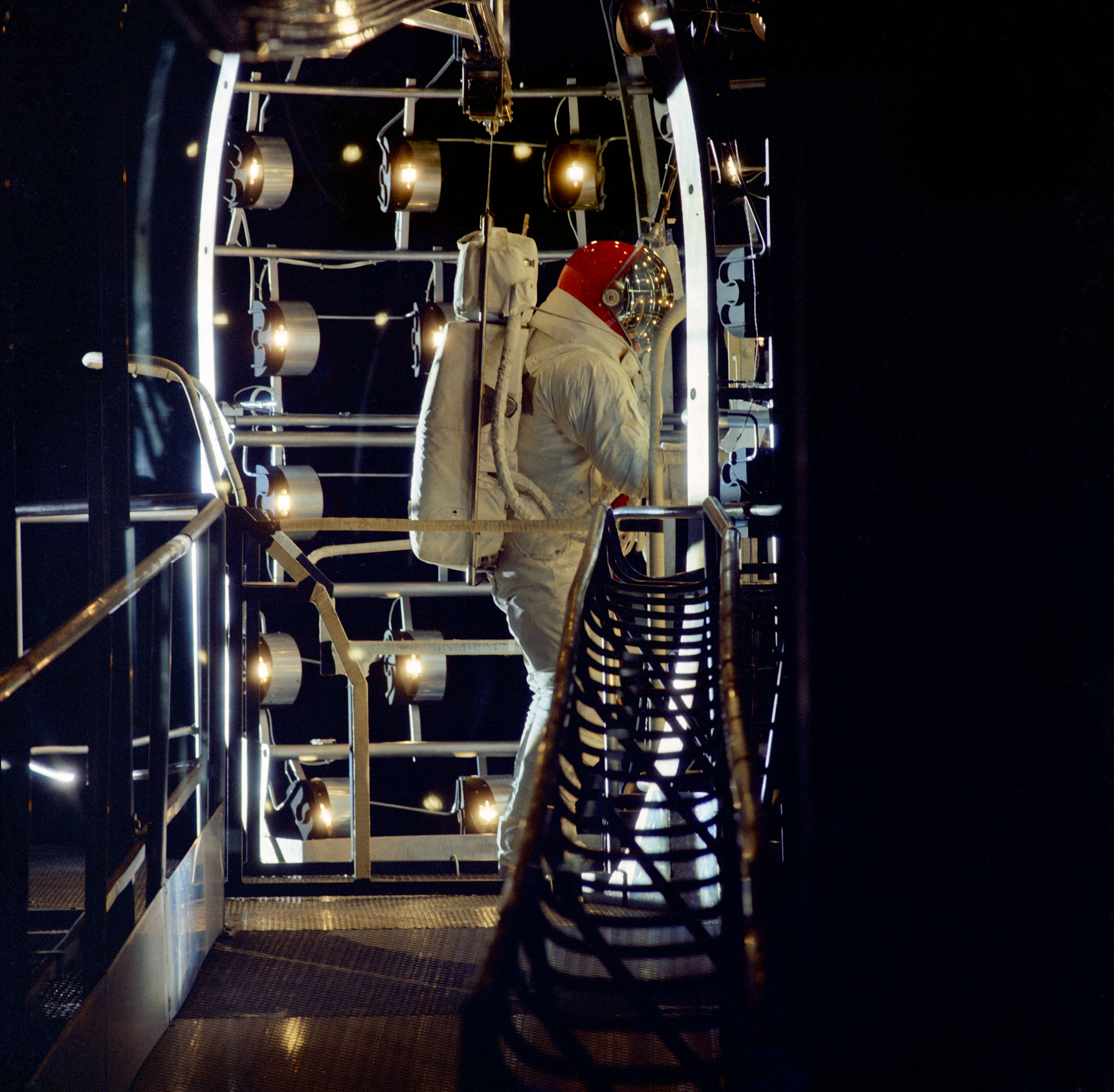
Apollo 9 prime and backup astronauts test the new Apollo A7L spacesuit in the Space Environment Simulation Laboratory at the Manned Spacecraft Center, now NASA’s Johnson Space Center in Houston. David R. Scott, left, Russell L. Schweickart, and Alan L. Bean.
International Latex Corporation (ILC) of Dover, Delaware, developed two versions of the Apollo A7L space suit for NASA – one for use exclusively inside the spacecraft, such as during launch, and the other that astronauts can also use during spacewalks, using the Portable Life Support System (PLSS) backpack. Both types of the suit could operate under vacuum conditions, but crew members wearing the inside version remained attached to the spacecraft via hoses that provided life support such as oxygen. The external version’s PLSS provided the required oxygen and communications during spacewalks outside the vehicle, for example on the lunar surface. For Apollo 9, McDivitt and Schweickart wore the external versions (even though McDivitt did not plan to do a spacewalk) while Scott wore the internal version. McDivitt, Scott, Schweickart, and Bean tested their A7L spacesuits with the PLSS under vacuum conditions in Chamber A of the Space Environment Simulation Laboratory at MSC.
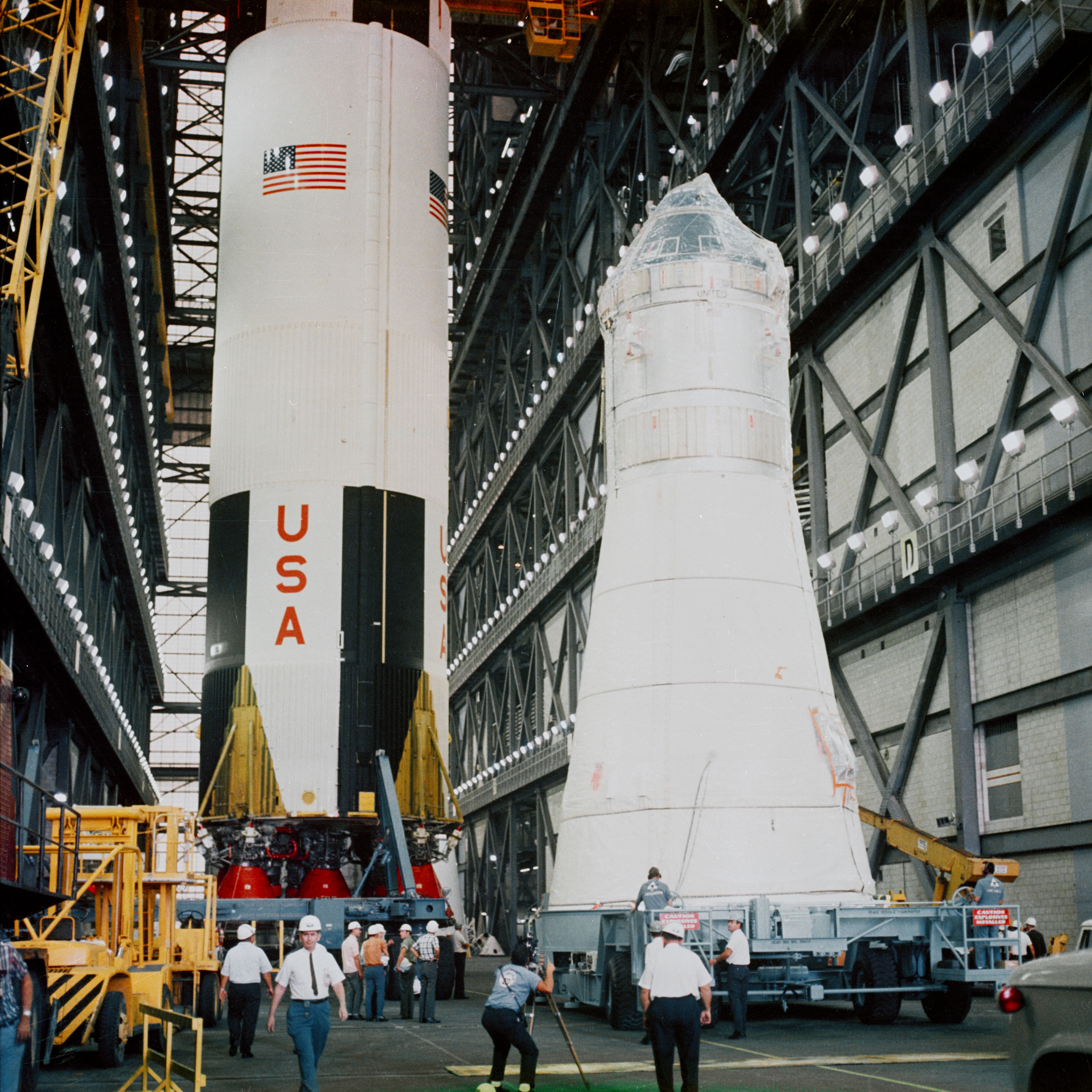


In the Vehicle Assembly Building at NASA’s Kennedy Space Center in Florida. Left: The assembled Apollo 9 spacecraft arrives from the Manned Spacecraft Operations Building, and shares space in the transfer aisle with the recently arrived Apollo 10 first stage. Middle: Workers hoist the Apollo 9 spacecraft in preparation for stacking onto the Saturn V rocket, with the Lunar Module’s landing gear visible. Right: Workers stack the Apollo 9 spacecraft onto its Saturn V rocket.
On Nov. 30, workers in KSC’s Manned Spacecraft Operations Building (MSOB) installed the Apollo 9 LM in its Spacecraft LM Adapter (SLA) and then stacked the CSM on top. They transferred the assembled spacecraft to the Vehicle Assembly Building (VAB) three days later where engineers stacked it atop its Saturn V rocket in High Bay 3. Rollout to Launch Pad 39A occurred in early January 1969.
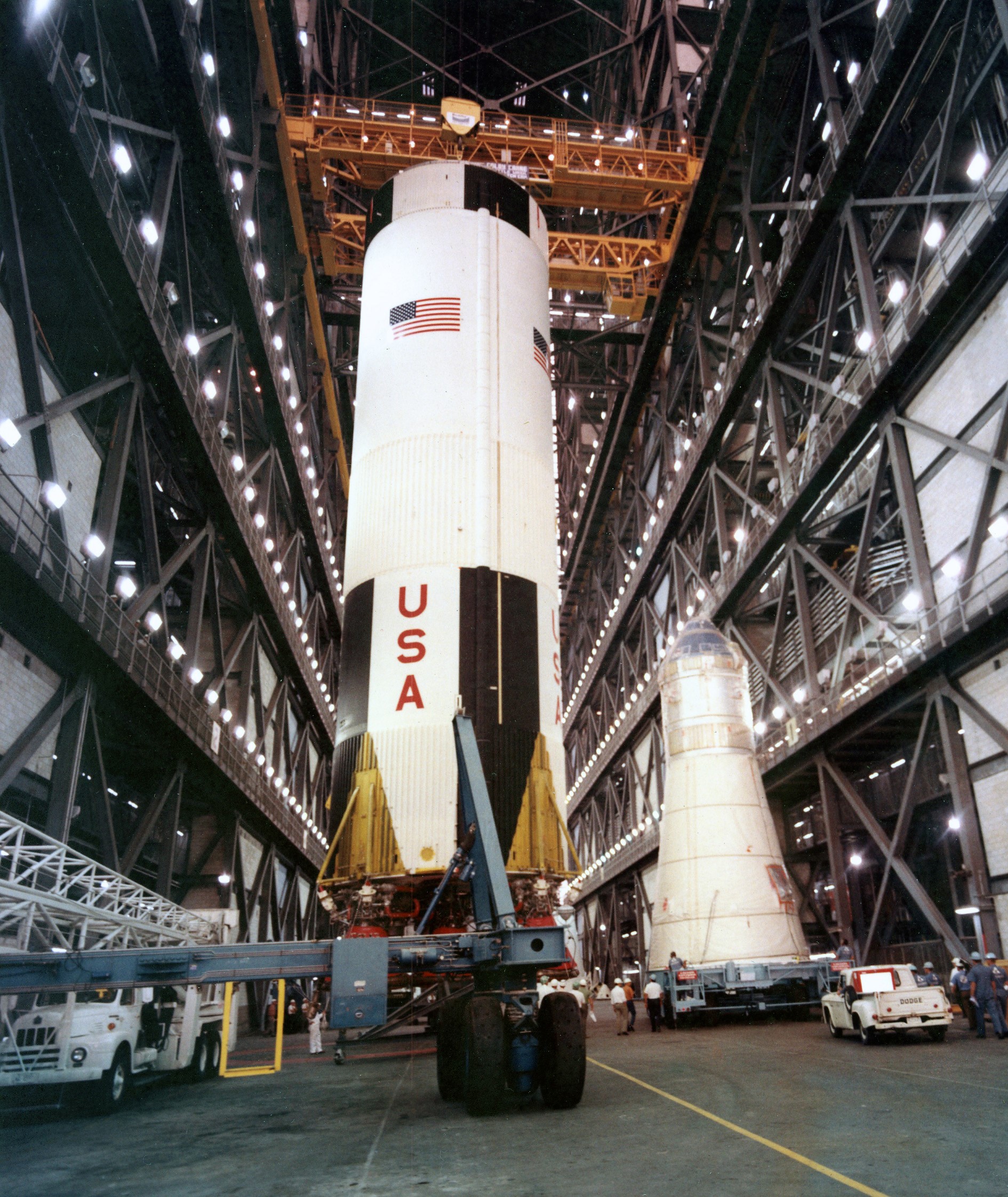

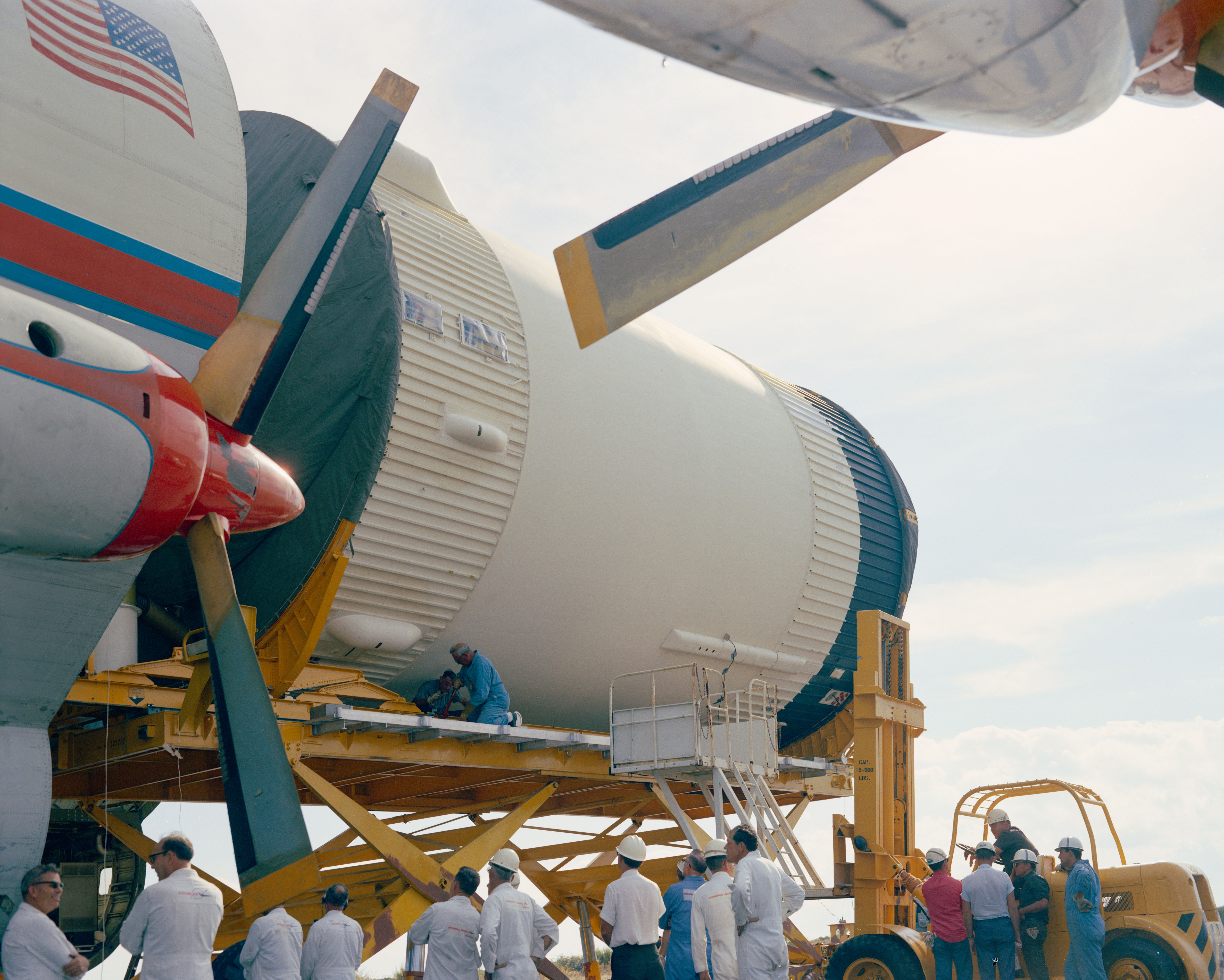
Left: Workers ready the Apollo 10 S-IC first stage for stacking onto the Mobile Launcher in the Vehicle Assembly Building at NASA’s Kennedy Space Center (KSC) in Florida. Middle: Workers stack the Apollo 10 S-II second stage. Right: The S-IVB third stage for Apollo 10 arrives at KSC.
Preparations continued for Apollo 10, the mission planned for May 1969 to test all the spacecraft components in lunar orbit as a possible dress rehearsal for the Moon landing. The Apollo 10 prime crew consisted of Thomas P. Stafford, John W. Young, and Eugene A. Cernan, the first all-veteran three-person crew, with L. Gordon Cooper, Donn F. Eisele, and Edgar D. Mitchell assigned as their backups. Stafford and Cernan planned to undock their LM and fly it to within nine miles of the lunar surface before rejoining Young in the CM. At KSC, in the VAB’s High Bay 2, by Dec. 7 workers had stacked the first two stages of the Apollo 10 Saturn V. The third stage arrived at KSC on Dec. 10 and workers stacked it atop the rocket on Dec. 29.

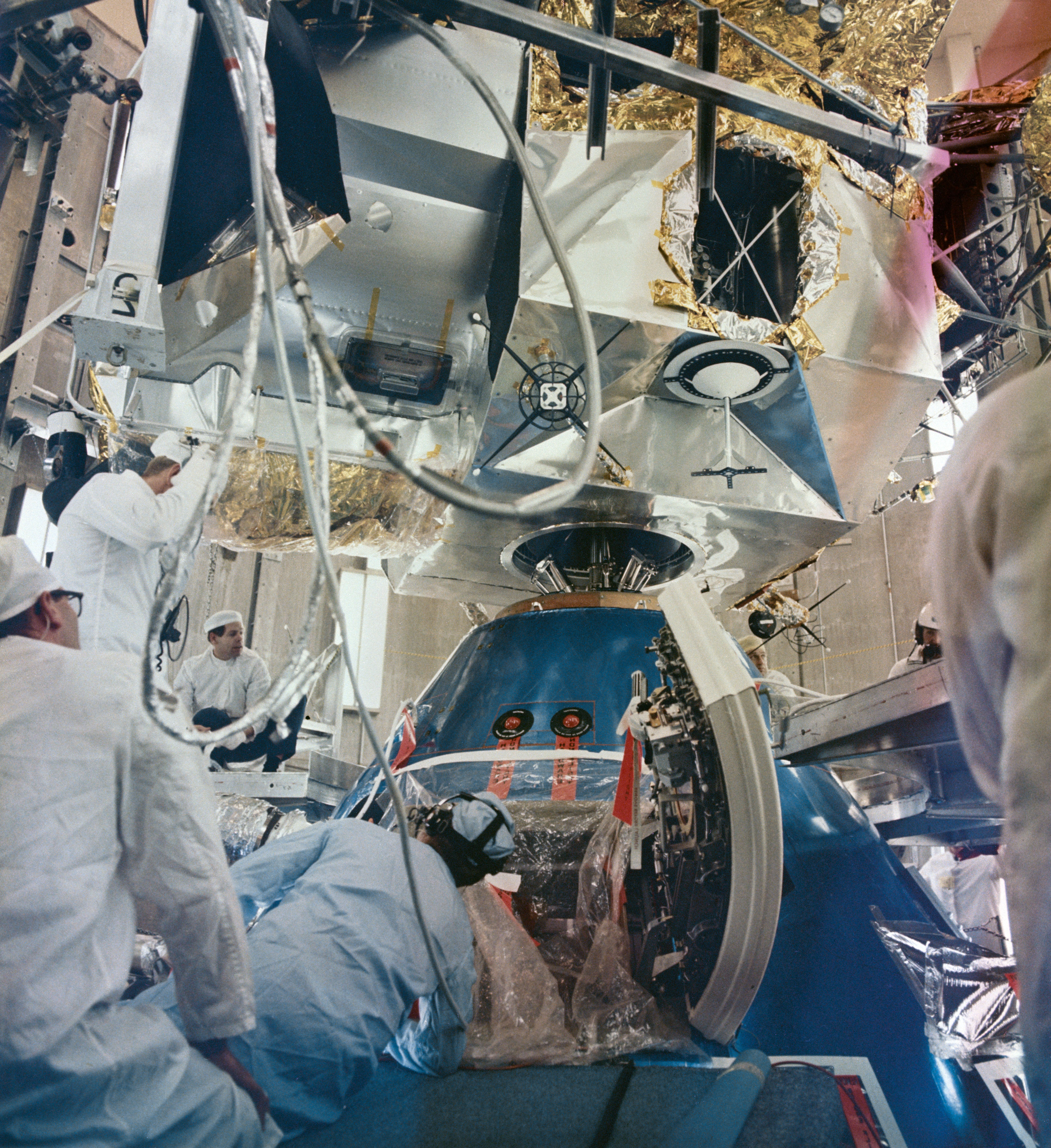

Apollo 9 spacecraft testing in the Manned Spacecraft Operations Building at NASA’s Kennedy Space Center in Florida. Left and middle: Simulated docking test between the Apollo 10 Lunar Module (LM), top, and Command Module. Right: Joining the LM’s ascent stage to the descent stage.
In the nearby MSOB, engineers performed a docking test of the Apollo 10 CSM and LM on Dec. 11. Following the test, workers mated the LM’s ascent and descent stages in a vacuum chamber in preparation for altitude tests in January 1969. In parallel, engineers conducted altitude tests with the CM, with prime and backup crews participating.



Left: Chief test pilot Joseph S. “Joe” Algranti ejects from the Lunar Landing Training Vehicle-1 (LLTV-1) with seconds to spare. Middle: The LLTV-1 explodes as it crashes to the ground. Right: Algranti floats safely to the ground under his parachute.
Apollo commanders used the Lunar Landing Training Vehicle (LLTV) to simulate flying the LM, especially the final 200 feet of the descent. Following Armstrong’s May 6, 1968, crash in an earlier version of the training aircraft, NASA grounded the fleet until engineers could take corrective action. Flights with LLTV-1 resumed at Ellington on Oct. 3, 1968, with MSC chief test pilot Joseph S. “Joe” Algranti at the controls. During the next two months, Algranti and fellow MSC pilot H.E. “Bud” Ream completed 14 test flights with LLTV-1 to check out the vehicle. Ream also piloted LLTV-2’s first two flights beginning Dec. 5. During LLTV-1’s 15th flight on Dec. 8, the final certification flight before resuming astronaut training, Algranti took the vehicle to 680 feet altitude and began a lunar landing simulation run. The vehicle began to oscillate in all three axes, which Algranti tried to control. But unexpected wind gusts exceeded the craft’s aerodynamic control limits and it began a sudden descent. At 100 feet altitude, and with less than a second to spare, Algranti ejected and safely parachuted to the ground with only minor bruises, but LLTV-1 crashed and burned beyond repair.
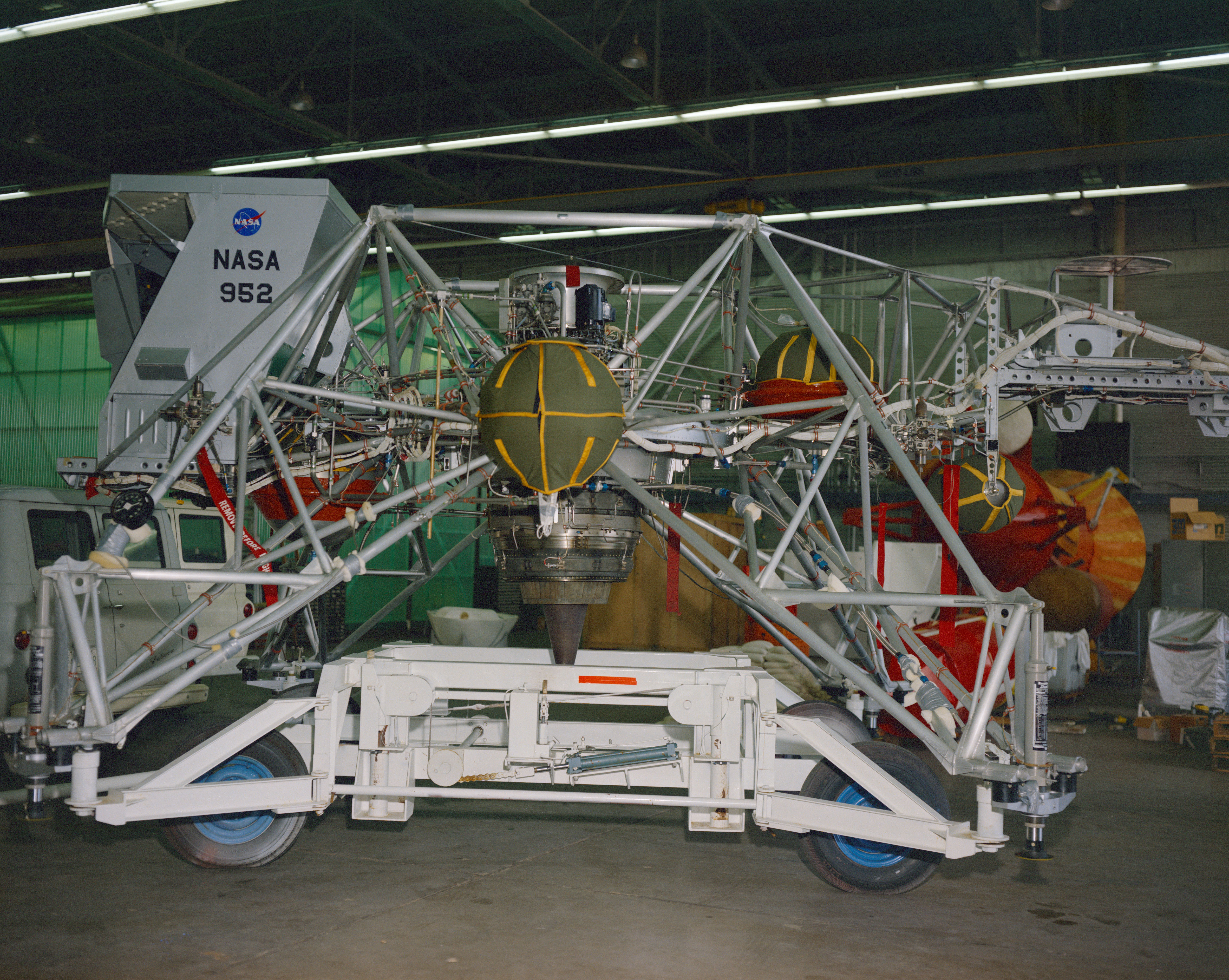

Left: At Houston’s Ellington Air Force Base, workers prepare the LLTV-3 for packing into the Super Guppy cargo plane. Right: Workers at Ellington load the LLTV-3 into the Super Guppy for shipping to NASA’s Langley Research Center in Hampton, Virginia, for wind tunnel tests.
Once again, NASA grounded the LLTVs and MSC Director Robert R. Gilruth set up an investigation board, chaired by NASA astronaut Walter M. Schirra. To better understand the vehicle’s aerodynamic characteristics, in late December NASA shipped LLTV-3 to the Langley Research Center in Hampton, Virginia, where engineers tested it in the wind tunnel. Findings from the board and from the Langley tests indicated that a gust of wind that overwhelmed the vehicle’s control limits caused the LLTV-1 crash, unrelated to Armstrong’s accident. Recommendations included increasing the level of thrust in the craft’s thrusters by 50 percent to provide an additional margin of safety.
News from around the world in December 1968:
Dec. 6 – The Rolling Stones release their album “Beggars Banquet.”
Dec. 7 – The United States launches the Orbiting Astronomical Observatory-2 space telescope.
Dec. 11 – President-elect Richard M. Nixon introduces his 12 Cabinet nominees.
Dec. 11 – The film “Oliver!” opens in the U.S.
Dec. 16 – Musical-fantasy film “Chitty Chitty Bang Bang” premieres in London and two days later in New York City.
Dec. 16 – Led Zeppelin’s concert debut in Denver, as opener for Vanilla Fudge.
Dec. 30 – Frank Sinatra first records “My Way.”
Share
Details
Related Terms
What's Your Reaction?



































